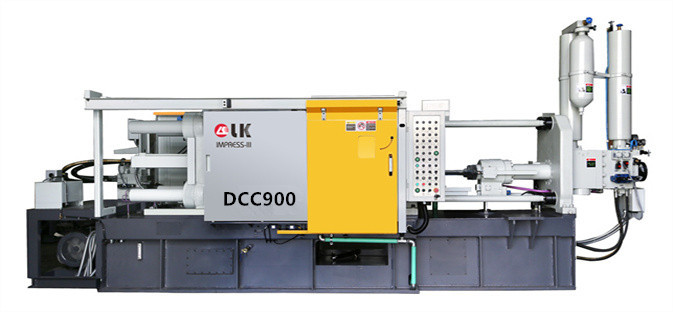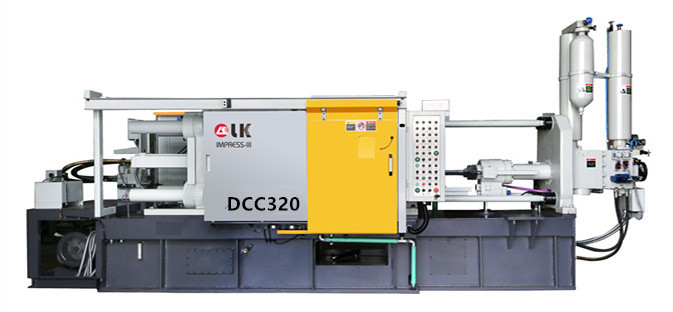What is Die Casting Equipment?
LK Die Casting Machine / 2024-07-03 16:36:38
Die casting equipment is a mechanical device used to inject molten metal into a mold for rapid prototyping. It plays a vital role in industrial production and is widely
used in the fields of automobile, aviation, home appliances, electronics, and mechanical manufacturing. This article will explore the definition, types, working principles,
main components, applications, and importance of die-casting equipment in modern industry.

Definition of die-casting equipment
Die casting equipment is a mechanical device that uses high pressure to inject molten metal into a pre-designed mold cavity. Through cooling and solidification,
the finished metal product has precise dimensions and complex shapes. The die-casting process can produce high-strength, high-precision, and high-complexity parts,
with the advantages of high production efficiency and low cost.
Types of die-casting equipment
Die casting equipment is mainly divided into two categories: hot chamber die casting machines and cold chamber die casting machines. The appropriate equipment type
is selected according to the type of molten metal and process requirements.
1. Hot chamber die-casting machine
A hot chamber die-casting machine is suitable for low melting point metals such as zinc, magnesium, and lead alloys. Its main feature is that the die-casting cavity and injection mechanism are partially
immersed in the molten metal, with a faster injection speed and higher production efficiency. The advantages of hot chamber die-casting machines include simple
structure, convenient operation, and easy automation.
2. Cold chamber die-casting machine
Cold chamber die-casting machines are suitable for high melting point metals such as aluminum, copper, and magnesium alloys. Its injection mechanism is separated
from the molten metal, and the molten metal is poured into the injection chamber manually or mechanically, and then injected under high pressure.
The advantage of the cold chamberdie-casting machines is that they can withstand higher melting points and greater injection pressures, and are suitable for manufacturing large and
high-strength parts.
Working principle of die-casting equipment
The working principle of die-casting equipment includes the following steps:
1. Molten metal preparation
The metal raw material is heated to a molten state in a melting furnace.
For hot chamber die-casting machines, the molten metal enters the die-casting cavity directly; for cold chamber die-casting machines, the molten metal is
injected into the injection chamber manually or mechanically.
2. Injection
The molten metal is quickly injected into the mold cavity under high pressure through a hydraulic or mechanical mechanism.
High-pressure injection ensures that the metal fills every corner of the mold to form a precise part shape.
3. Cooling and solidification
The molten metal cools and solidifies in the mold to form a solid metal part. The cooling time varies depending on the type of metal and the size of the part.
4. Mold opening and part removal
The mold is opened and the formed metal parts are removed. This process can be done manually or automatically by mechanical devices.
5. Cleaning and processing
The removed metal parts are cleaned to remove excess parts such as burrs and flash.
As needed, the parts may also undergo subsequent processing, such as surface treatment, heat treatment, etc., to meet specific usage requirements.
Main components of die-casting equipment
Die-casting equipment consists of multiple key components, which work together to complete the die-casting process. The main components include:
1. Frame
The frame is the basic structure of the die-casting equipment, providing stable support and fixation.
The frame is usually made of high-strength steel to ensure stability and safety under high-pressure operation.
2. Injection system
The injection system is the core part of the die-casting equipment, which is used to inject molten metal into the mold.
The injection system mainly includes components such as an injection cylinder, injection rod, and hopper.
3. Mold clamping system
The mold clamping system is used to fix and maintain the closed state of the mold to ensure that the mold does not leak during the injection process.
The mold clamping system mainly includes a fixed template, a mobile template, and a hydraulic cylinder.
4. Control system
The control system is used to adjust and control the operating parameters of the die-casting equipment to ensure the normal operation of the equipment.
The control system mainly includes a PLC controller, a touch screen, and a sensor.
5. Cooling system
The cooling system is used to cool the mold and the formed metal parts to accelerate solidification and improve production efficiency.
The cooling system mainly includes a cooling water channel, a cooling water pump and a heat exchanger.
6. Hydraulic system
The hydraulic system provides power for the die-casting equipment and drives the injection and clamping system.
The hydraulic system mainly includes a hydraulic pump, a hydraulic valve, and a fuel tank.
7. Electrical system
The electrical system provides power support for the die-casting equipment and ensures the normal operation of each electrical component.
The electrical system mainly includes a power module, a motor, and an electrical control cabinet.
Application of die-casting equipment
Die-casting equipment is widely used in many industrial fields, mainly including:
1. Automobile industry
Die-casting equipment is used to produce automobile engine blocks, gearbox housings, wheels, doors, and various structural parts.
These parts require high strength and high precision, and the die-casting process can meet these requirements and improve production efficiency.
2. Aviation industry
The aviation industry requires lightweight and high-strength parts, such as aircraft engine components and structural parts.
The die-casting process can produce high-performance parts that meet aviation industry standards.
3. Electronics industry
Die-casting equipment is used to produce parts such as radiators, housings, and connectors in electronic equipment.
These parts require high precision and good thermal conductivity, and the die-casting process can achieve these requirements.
4. Home appliance industry
The home appliance industry requires a large number of metal parts, such as various parts in washing machines, refrigerators, and air conditioners.
The die-casting process can efficiently produce these parts, reduce costs, and improve product quality.
5. Machinery Manufacturing
The machinery manufacturing industry requires various complex shapes and high-precision parts, such as gears, bearing seats, and pump bodies.
The die-casting process can meet these requirements and improve production efficiency and part quality.
The Importance of Die Casting Equipment in Modern Industry
Die-casting equipment plays an important role in modern industry, and its main advantages include the following:
1. High production efficiency
The die-casting process can produce a large number of metal parts in a short time, which is suitable for large-scale production and significantly improves production efficiency.
2. High precision and complexity
The die-casting process can produce metal parts with precise dimensions and complex shapes to meet various industrial needs.
3. High material utilization rate
The die-casting process has a high material utilization rate, which reduces metal waste and reduces production costs.
4. Excellent mechanical properties
Die-casting parts have good mechanical properties, such as high strength, high hardness, and good wear resistance, and are suitable for various complex working
environments.

Summary
Die casting equipment is a key industrial machinery that is widely used in many fields. By understanding the definition, types, working principles, main components,
and applications of die-casting equipment, readers can better understand its importance in modern industry. The efficient production capacity and excellent part
quality of die-casting equipment makes itan indispensable and important tool in modern manufacturing. I hope this article can provide valuable reference information for readers
who need to understand die-casting equipment.
Contact LK Egypt to learn more info about the die-casting machine.
LKAGENT OFFICE DCM
Address: Industry Zone, South of Port Said Kebly, Egypt
https://www.zazdiecasting.com/
Phone: +86 13598704163
Mobile: +20 101 304 3317 +20 150 181 8310
Email: jack@zazmae.com ahmedmahmoud@zazmae.com
#die cast tooling
#trivalent chromate
#rapid prototype casting
#a360 aluminum
#aluminum caster
#aluminum prototype
#ideal 55 slider parts
#density of aluminum kg/mm3
#magnesium sheet metal
#parts of a metal gate
#subcontracting of screw machining for the luxury sector
#wall aluminum
#die casting tooling
#tooling for die casting
#density of aluminium in kg mm3
#clear chromate
#es casting metals
#gating material
#prototype aluminum
#sigma castings
#subcontracting of screw-machining for household appliances
#we squeeze to please machine
#aluminium gravity die casting
#aluminum part
#aluminum rapid prototyping
#nickel casting
#plunger tip for die casting machine
#rapid prototyping aluminium
OTHER CONTENT
-

2024-09-19 14:16:15 LK Cold Chamber Die Casting Machine DCC900 Locking Force: 9000KN Die Height: 400-1000mm Space Between Tie Bars: 930x930mm Shot Weight: 13.5Kg Casting Area Max:2250c㎡
More -

2024-09-19 14:11:06 LK Cold Chamber Die Casting Machine DCC280 Locking Force: 2800KN Die Height: 250-650mm Space Between Tie Bars: 560x560mm Shot Weight: 2.9Kg Casting Area Max:700c㎡
More -

2024-09-19 10:23:07 LK Cold Chamber Die Casting Machine DCC580 Locking Force: 5000KN Die Heigh: 350-850mm Space Between Tie Bars: 760x760mm Shot Weight: 6.9Kg Casting Area Max:1250c㎡
More -

2024-09-19 10:11:20 LK Cold Chamber Die Casting Machine DCC400 Locking Force: 4000KN Die Height: 300-700mm Space Between Tie Bars: 669x669mm Shot Weight: 4.7Kg Casting Area Max:1000c㎡
More

